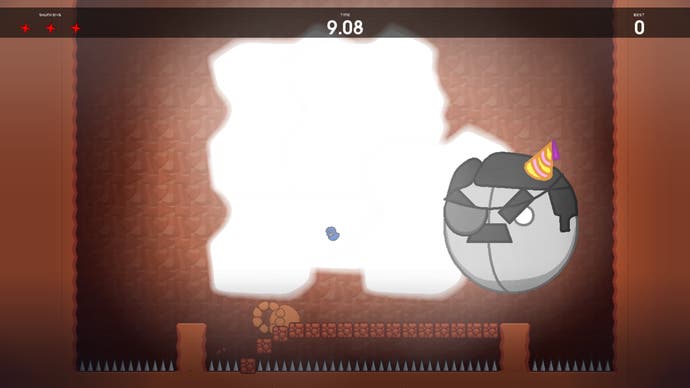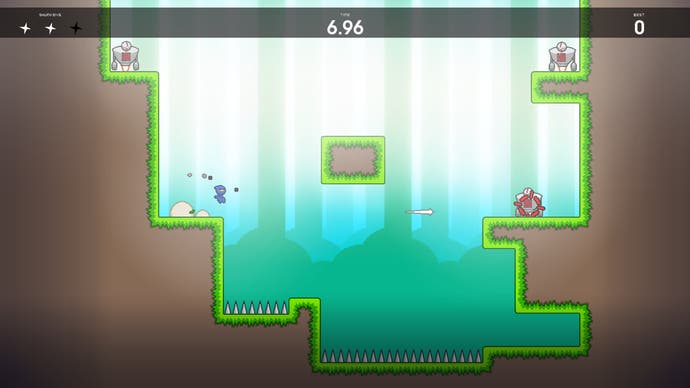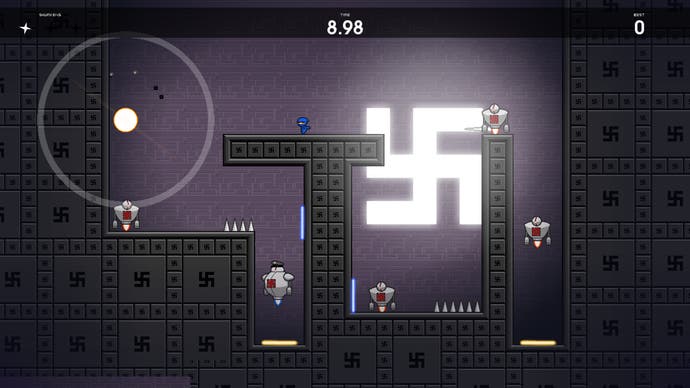10 Second Ninja review
Speed kills.
The assumption that PC players now all keep a scruffy 360 controller wrapped up next to their hulking towers is letting developers really push their Steam wares further into console territory. 10 Second Ninja, a meticulously well-designed flash of breakneck speed and pixel-perfect precision, is purpose-built for a controller and nearly impossible to enjoy without.
If most indie platformers have sought to expand and experiment with this most classic of video game genres, 10 Second Ninja does the opposite. This is pure distillation - single-screen, multi-tiered arenas guarded by static robots. And they ask just one question - can your little ninja kill them all in 10 seconds?
The answer, unanimously, is yes, but you soon realise that '10 second' moniker indicates a bare minimum. Your ninja is a lithe and agile chap, capable of a snappy double jump, a broad katana slash, and dead-eye accuracy with a shuriken. For the most part, it'll only take one hit from a sword or shuriken to kill a robot, and even the later levels can easily be conquered in under 10 seconds, awarding you one of three stars.

The first level is the hook; the robots can easily be slaughtered in the allotted time, and the game quickly awards you a "new record" and then tempts you back with the casual message: "Next star in 0.34 seconds." You could try the next level, of course, but surely you can shave less than half a second off your time? Your friends have - just look at the leaderboards! And so it begins.
The demands for two stars are always reasonable, letting you feel like you're making progress and that your ninja skills are growing steadily. Three stars, though, demands perfection. Absolute, pixel-flawless perfection. You'll get agonisingly closer to that three-star ranking: 0.5 seconds. 0.24 seconds. The horror of 0.01 seconds. And then you'll hit it. It might take 10 restarts; it might take 500. But when you hit it and "YOU GOT ALL THE STARS" lights up the screen, the glory is real, the triumph tangible.
None of this would work without 10 Second Ninja's faultless controls. One-man design guru Dan Pearce has built each of the game's 40 levels (plus bonus stages) around the exact movement and limitations of the ninja. Ingeniously, you only have three shurikens at a time, and levels become puzzles. Do you fire off two shurikens to take out the enemies on your left and right before embarking on a rapid-fire double-jump sword-slash extravaganza? Or are those guys meant for later, teasing you into a wrong path that will never grant you that elusive trio of stars?
Success makes you feel like Neo: a flash of thumbs and shifting palms, over before it begins, death all around you

Enemy robots are highlighted with a pulsing red target when they're in range of a shuriken, and explode with a punchy joypad rumble (further endorsement for playing on a pad) and a metallic crunch. Even enjoyed (relatively) slowly, 10 Second Ninja has the gratifying feedback of Super Meat Boy, but when it's played at its quickest, Dan Pearce's game is extraordinarily satisfying. Success makes you feel like Neo: a flash of thumbs and shifting palms, over before it begins, death all around you.
For such a refined piece of design, the decision to hide 10 Second Ninja's critical paths will prove divisive. While figuring out the solutions to early levels is rewarding, later stages introduce new factors; crumbling platforms which can kill enemies below, robots that require a second strike, even teleporters. Variety is a boon for those finding the 10 Second Grind a little weary, but it's a nightmare for anyone desperately trying to three-star every level.
Repeatedly traipsing down the wrong path is agonising. I spent over 200 tries on one mid-game mission before figuring out a better solution. Some will enjoy finding that path themselves, but for me the true joy is in the execution rather than blindly figuring out the answer. Thankfully, three-star runs have already lit up YouTube, and you should feel no shame in asking for help. Just because you know how to perfect a level doesn't mean you can actually do it. Even with all the answers, 10 Second Ninja isn't going to hold your hand.

Despite 10 Second Ninja being a marvellously well designed and air-punchingly triumphant video game, then, it's still hard to shift the nagging guilt that haunts its every brightly-lit platform. It's the same sensation that creeps in during a lengthy session of Trials or Super Meat Boy. The compulsion is real and, at the time, all-encompassing. But after 200 instant restarts (and 10 Second Ninja might have the most instant of all restarts), it's tough to shake the feeling that you should maybe be doing something more productive with your time.
That's hardly the most damning of criticisms, though, especially as there's almost no way 10 Second Ninja could avoid it without changing its fundamental essence. The story is another matter. It doesn't need one, and the decision to frame the game with a robot Hitler and cover the bad guys in swastikas doesn't help its cause when your brain is seeking out something more nourishing.
Thankfully, Steam is a broad enough platform to offer all kinds of enriching, artful, emotive experiences alongside a sliver of pure gameplay like 10 Second Ninja. In fact, there's art here too - the art of design, of precision and compulsion. 10 Second Ninja is a brief but expertly built piece of work; a game that offers the most hardcore of action-platforming but does so under the guise of simplicity and accessibility.
It's time to unravel that 360 pad. I'll give you 10 seconds.

